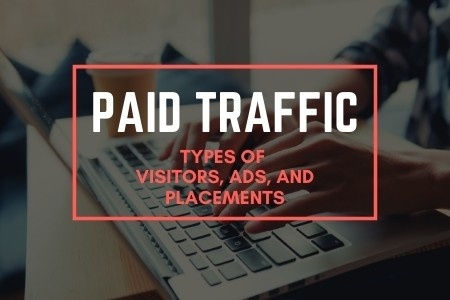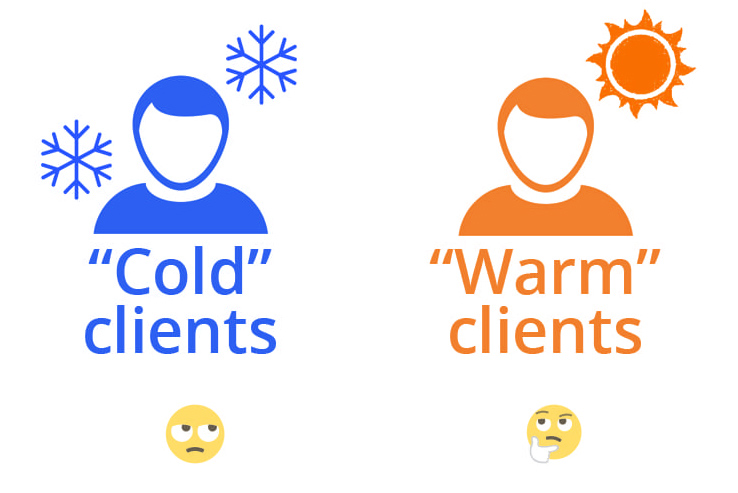Blog "Fast Dynamic SEO" Paid Traffic. Types of visitors, Ads, and Placements
19th October, 2020

You made a significant step. You made a website. Congratulations!
It isn't easy to promote your services if you don't have a page where you may direct people interested in your services for converting them to the clients.
But keep in mind a critical point:
"It's not enough to have a website. It must be found."
Here I will give a little background information for reflection and, in general, to help you figure things out.
Table of content:
Sources of website visitors
So, there exists a few sources of visitors for your website:
- Direct visitors. These are the people who got your address from friends, saw your store or your street ad, or wrote down your URL. People come to your website “from offline”. This also includes people who already know about you, and remember to save your URL in bookmarks.
- From Paid Ads. Here everything looks very simple. You create ads, paid to Google/Facebook. People can click on your ads to see your website. But customizing advertisements, targeting, management, and budgeting isn’t so simple. It's easy to waste a lot of your money over this.
- Organic visitors. These are the visitors who search and found your website through the search engine. Someone types a request in the search bar, discovers your website, and clicks there. To promote your website in this way, you have to do search engine optimization. It's somewhat complicated. I call it ”pushing a train.” You should push it (promote) for a long time to speed it up. But, stopping it later won't be easy, as it will increase new visitors’ flow for a long time.
After creating your website, I tell you to wait a bit and let Google score your website. It will check the whole website and let you know what's wrong and how it looks. On this basis, you may start to improve the website and begin an optimization. Of course, it's great if you already made a competent website (stylish look and correct inside). And if you have a budget, you shouldn't delay SEO.
Also, it would help to create Business pages on social networks. Think of a publishing strategy there. Organic traffic will increase if you make good quality content. But at the beginning of your business survey is very difficult to get the attention of a social network's AI.
That's why, for quick first results, you have to attract visitors through paid Ads.
Type of visitors from Paid Ads

When it comes to online marketing, you need to understand the types of customers on the Internet. I split them into two individual groups:
- Warm clients
- Cold clients
This is not about body temperature but about how they are ready to become your clients and use your goods or services.
So, we need to approach each of these groups of clients by different ways, depends on their group's type.
90% of potential customers are not ready to buy right now
So, let's talk about each group and then how to work with them.
Warm clients
Lost clients. These are people who already know you and your brand — they are already using your services. However, for some reason, they forgot about you or maybe lost contact. This group includes people who don't see your news because "smart feed" didn't show your posts to them. Social Network's AI decided your content is not good enough for them.
Offline clients. Another set of people who lie in this group. They visited your store, bought some product (used some services), but never followed your page for whatever reason. Or your page isn't on the social network of which these people use.
Anyway, all these clients are already loyal to you and your brand. You need to remind them about yourself and involve them in participating in the page's life. Even if they aren't using your services now, they will remember you when they need your services.
Seeking clients. One more part of people who can be called ”warm”. They are looking at the internet for services that you provide or the goods you sell. They need it now, and if you will ”catch” them, show them your offer, then it’s a big chance they will become your clients. The most difficult part is ”how to find these people?”
Cold clients
This is the group of people that could potentially become your customers. By large, they are your target audience. They may need your product and have the funds to buy it, and actually, they might benefit from it, but they don't know about it yet.
How is it possible? Well, for example, overweight people know they need to exercise, diet, and maintain their health. This means they need the service of a trainer, nutritionist, or doctor. But unless they realize that (and do something), all ads for such goods and services will go unnoticed.
How can you find your client?
Yes, that is the main question. As well as a few more:
- Where to look for these types of people?
- How do you find these types of people?
- How can you show advertisements to the right people?
- How do you not miss a client if he/she has already reacted to Ads or visited my website?
Client's intent
I'm sure you will agree that the main difference between warm and cold clients is how they show their interest. Clients have a desire. They are looking for something and would like to investigate the topic. And only after they will choose where to buy. In any case, the client will show interest in you. And of course, it is much easier to sell your service or product to such a client.
So, the first conclusion derived from this is:
"Sell first to the warm clients!"
Now, that we know the types of clients, let's get back to advertising.
Ad Placements
You can advertise on the Internet using a few types of platforms:
- Search engines (Google, Yandex, Bing, etc.)
- Social Networks (Facebook, Instagram, Pinterest, Twitter, etc.)
- Thematic websites (via partners or directly)
Search engines and social networks allow you to target advertising by different criteria. To not waste your budget, most of the effort is better directed towards catching warm clients.
The targeting options are different for search engines and social networks. They have similar things in common, such as gender, age, and location of visitors. But completely different in detail. Same as the goals/methods of your website and your Social Page.
Features of Social networks and websites
Globally, you sell your services on both your website and social media. And of course, the main goal is to make money. But there is a huge difference between people's expectations in these placements. Hence why we have to use specific promotion models. So, let's look deeper.
A Website Specificities
A website is an online store and showroom where you clearly express:
"Here is the product, its description, and its cost."
On the website, you can show your competence through useful articles, videos, infographics. You can control everything, how it looks, sizes, fonts, location, and places. You are the manager. If someone visits your website, then you control how and what to show.
Social Network page specificities
In contrast to this, social networks limited your design, placements, font sizes, and many other things. Your page on a social network is a news feed that should also inspire confidence but in entirely different ways.
On social networks, you will make friends by creating posts with the main message, ”Buy here!”
And that's how you will gain (followers). People who will follow you. They have the option to click the like button of the product-service to keep up to date. It’s kind of they say:
"Ok, let's subscribe so that I can use it later and not forget."
However, If you post boring content on your feed, people won’t want to associate with such ”friends” and thus unsubscribe.
But if the feed contains exciting content to watch and learn from, you become an expert, and people perceive and feel that. Such posts inspire confidence in your product and brand, establishing a clear message in the client's mind: ”this brand is good.”
Types of Ads
According to this it shows different ads for different customer types on different platforms. It will be more profitable. Therefore, first, let's take a look at what types of advertising there are.
Search Engine Paid Ads
Google (and other search engines) allows show ads of two types: search and contextual. They differ in these placements.
Search ads show when a person searches for something and gets a list of organic search results. Before organic search results appear, ads with tiny marks ”Ad” on the top of this list.
Contextual ads from search engines show banners on Google partners' websites. Also, with tiny marks ”Ad” or ”Sponsored.”
You can agree that good ads are:
- Ads that solve the current question;
- Ads that attract but aren't annoying;
So, the search ads are exactly like that.
The person enters a request, thereby showing a desire to get some services or goods (warm client).
Social Network Paid Ads
Social networks are placing all ads in news feeds, stories, mixing them into your regular feed. Therefore, all ads on social networks are contextual.
Which type of targeting you will use for this is up to you. Targeting means various parameters and characteristics that you will use to show your ads to the ”right” people. And this is the hardest part of social media promotions.
The more expensive a product or service is, the more time a person needs to decide.
The person will go to other websites or social pages to look and compare.
But the person has already shown an interest in your goods or services. That's why I call such people ”warm clients,” and that’s why you should not miss them.
And now, I want to tell you about the type of target for which social networks are the best.
Retargeting for warm clients
Here is an Internet tracking technology that comes in. No, this is not spyware. But if you have special codes from search engines or social systems installed on your site, they tag such a user. And when this client appears to be ”on their territory,” you can show your advertisement to this person.
Ads that are showing to such" tagged users" are called "retargeting ads." I call them "catching up ads." Remind the customer about yourself and attract the user to revisit your website or page. You can try to sell the product immediately in advertising. But it's better to invite this person to your website or page for an interesting article. And then, there you have a chance to get a subscriber to your page. There are many options. But this is definitely a "warm client," and you should not miss this opportunity.
Search engine retargeting ads show banners on partner sites in special places. So, all ads in social networks are contextual — they fit into your context (feed) and try to look like regular posts.
Social networks tag a visitor when they react (click like, write a comment, etc.) on any of your pages or posts. And this is where retargeting advertising comes into play. For example, if someone looked at your page on Instagram, he/she interested in your topic. That means you can start showing her/him your advertising posts.
What about cold clients?
I do not recommend spending a lot of money on such a client. Take max 5-15% of the total budget and do not try to sell something immediately. The chance of success is meager.
Search engines and social networks have metrics to narrow down the pool of potential cold clients:
- By demographic metrics (age, gender)
- By geographic metrics (city, country)
- By technical details (such as the model of gadget)
- By interests (what do they like)
- By behavior (where do they go, how often)
But anyway, it is still an advertisement for ”everyone,” which means ”for no one.”
Possibly potential clients
It's a part of ”cold” clients, which social networks think might become your clients.
Social networks have a ”lookalike” system. It uses artificial intelligence to select people similar to your real customers. Or to another group of what you selected as a source. And then filters and targets by all available metrics. And even after that, this audience still can have only ”cold” clients.
Search engines also have a similar system. Your ads will show as contextual advertising to people who have shown interest in a specific topic. For example, you are a travel agency and sell tours to Thailand. The request for which you show your ad is ”tour to Thailand.” But the person did not use such a request. He made a request for ”Thailand” on Google search and read articles about this country. But Google has already noted that this person is interested in Thailand. If you have such a setting, then this person has been tagged as your potential customer. After filtering by other metrics, your contextual advertising starts showing to him. Perhaps he will see your banner and be interested in your services and go to your site. And then retargeting will catch them.
Conclusions
- When starting to promote your business on the Internet, be sure to create a website, and run social networks.
- Create a good website and share good and useful content to your social network.
- For new customers, firstly use search ads.
- Use social media ads ONLY through retargeting or to existing customers.
- Use contextual advertising ONLY with some useful content. Do not try to sell something right away.
Related posts:
-
Free Basic
Analysis of WebsiteFill out the form and get recommendations.




Your comment: